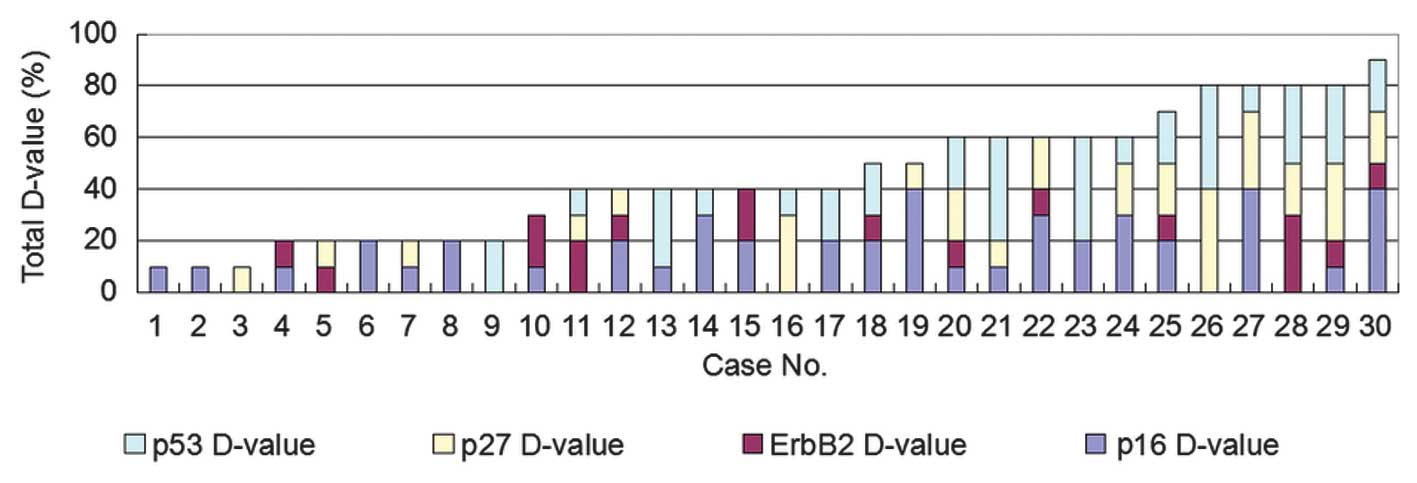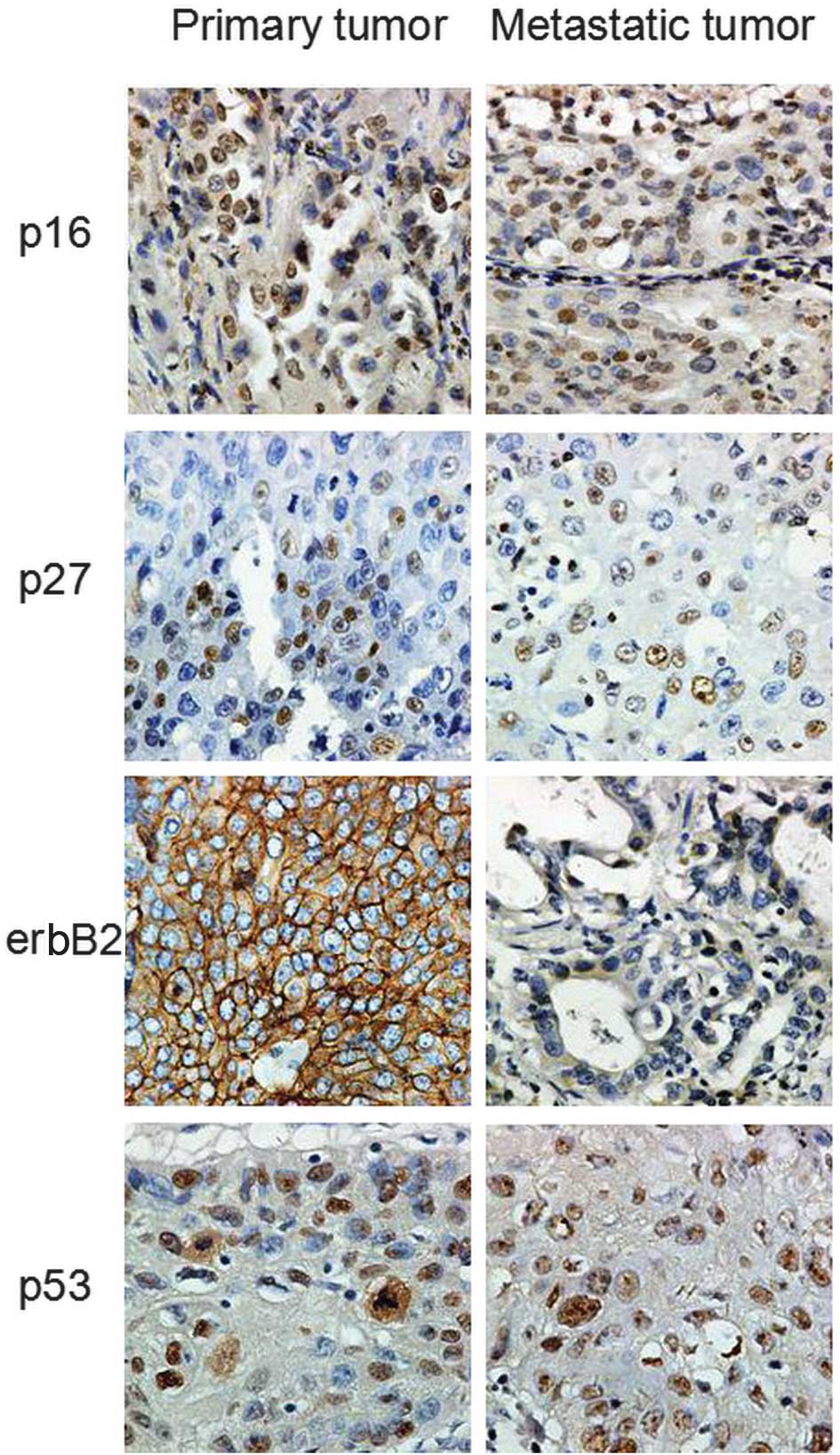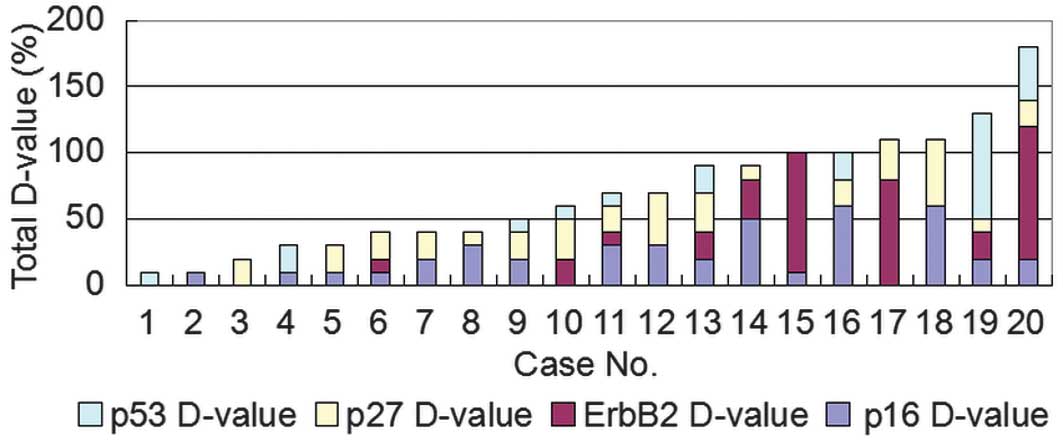|
1
|
Ferguson MK, DeMeester TR, DesLauriers J,
et al: Diagnosis and management of synchronous lung cancers. J
Thorac Cardiovasc Surg. 89:378–385. 1985.PubMed/NCBI
|
|
2
|
Adebonojo SA, Moritz DM and Danby CA: The
results of modern surgical therapy for multiple primary lung
cancers. Chest. 112:693–701. 1997. View Article : Google Scholar : PubMed/NCBI
|
|
3
|
Martini N and Melamed MR: Multiple primary
lung cancers. J Thorac Cardiovasc Surg. 70:606–612. 1975.PubMed/NCBI
|
|
4
|
Sugio K, Kishimoto Y, Virmani AK, et al:
K-ras mutations are a relatively late event in the pathogenesis of
lung carcinomas. Cancer Res. 54:5811–5815. 1994.PubMed/NCBI
|
|
5
|
Kishimoto Y, Sugio K, Hung JY, et al:
Allele-specific loss in chromosome 9p loci in preneoplastic lesions
accompanying non-small-cell lung cancers. J Natl Cancer Inst.
87:1224–1229. 1995. View Article : Google Scholar : PubMed/NCBI
|
|
6
|
Wistuba II, Behrens C, Milchgrub S, Bryant
D, Hung J, Minna JD and Gazdar AF: Sequential molecular
abnormalities are involved in the multistage development of
squamous cell lung carcinoma. Oncogene. 18:643–650. 1999.
View Article : Google Scholar : PubMed/NCBI
|
|
7
|
Aoyagi Y, Yokose T, Minami Y, et al:
Accumulation of losses of heterozygosity and multistep
carcinogenesis in pulmonary adenocarcinoma. Cancer Res.
61:7950–7954. 2001.PubMed/NCBI
|
|
8
|
Strong MS, Incze J and Vaughan CW: Field
cancerization in the aerodigestive tract - its etiology,
manifestation, and significance. J Otolaryngol. 13:1–6.
1984.PubMed/NCBI
|
|
9
|
Matsuzoe D, Hideshima T, Ohshima K, et al:
Discrimination of double primary lung cancer from intrapulmonary
metastasis by p53 gene mutation. Br J Cancer. 79:1549–1552. 1999.
View Article : Google Scholar : PubMed/NCBI
|
|
10
|
Hiroshima K, Toyozaki T, Kohno H, Ohwada H
and Fujisawa T: Synchronous and metachronous lung carcinomas:
molecular evidence for multicentricity. Pathol Int. 48:869–876.
1998. View Article : Google Scholar : PubMed/NCBI
|
|
11
|
Mitsudomi T, Yatabe Y, Koshikawa T, et al:
Mutations of the P53 tumor suppressor gene as clonal marker for
multiple primary lung cancers. J Thorac Cardiovasc Surg.
114:354–360. 1997. View Article : Google Scholar : PubMed/NCBI
|
|
12
|
Mountain CF: Revisions in the
International System for Staging Lung Cancer. Chest. 111:1710–1717.
1997. View Article : Google Scholar : PubMed/NCBI
|
|
13
|
Tsukamoto S, Sugio K, Sakada T, et al:
Reduced expression of cell-cycle regulator p27 (Kip1) correlates
with a shortened survival in non-small cell lung cancer. Lung
Cancer. 34:83–90. 2001. View Article : Google Scholar : PubMed/NCBI
|
|
14
|
Osaki T, Mitsudomi T, Oyama T, Nakanishi R
and Yasumoto K: Serum level and tissue expression of c-erbB-2
protein in lung adenocarcinoma. Chest. 108:157–162. 1995.
View Article : Google Scholar : PubMed/NCBI
|
|
15
|
Dobashi K, Sugio K, Osaki T, Oka T and
Yasumoto K: Micrometastatic P53-positive cells in the lymph nodes
of non-small-cell lung cancer: prognostic significance. J Thorac
Cardiovasc Surg. 114:339–346. 1997. View Article : Google Scholar : PubMed/NCBI
|
|
16
|
Taga S, Osaki T, Ohgami A, et al:
Prognostic value of the immunohistochemical detection of p16INK4
expression in non small cell lung carcinoma. Cancer. 80:389–395.
1997. View Article : Google Scholar : PubMed/NCBI
|
|
17
|
Pommier RF, Vetto JT, Lee JT and Johnston
KM: Synchronous non-small cell lung cancers. Am J Surg.
171:521–524. 1996. View Article : Google Scholar : PubMed/NCBI
|
|
18
|
Mathisen DJ, Jensik RJ, Faber LP and
Kittle CF: Survival following resection for second and third
primary lung cancers. J Thorac Cardiovasc Surg. 88:502–510.
1984.PubMed/NCBI
|
|
19
|
Rosengart TK, Martini N, Ghosn P and Burt
M: Multiple primary lung carcinomas: prognosis and treatment. Ann
Thorac Surg. 52:773–779. 1991. View Article : Google Scholar : PubMed/NCBI
|
|
20
|
Lau DH, Yang B, Hu R and Benfield JR:
Clonal origin of multiple lung cancers: K-ras and p53 mutations
determined by nonradioisotopic single-strand conformation
polymorphism analysis. Diagn Mol Pathol. 6:179–184. 1997.
View Article : Google Scholar : PubMed/NCBI
|
|
21
|
Wang X, Christiani DC, Mark EJ, et al:
Carcinogen exposure, p53 alteration, and K-ras mutation in
synchronous multipleprimary lung carcinoma. Cancer. 85:1734–1739.
1999. View Article : Google Scholar : PubMed/NCBI
|
|
22
|
Ribeiro U, Safatle-Ribeiro AV, Posner MC,
et al: Comparative p53 mutational analysis of multiple primary
cancers of the upper aerodigestive tract. Surgery. 120:45–53. 1996.
View Article : Google Scholar : PubMed/NCBI
|
|
23
|
Leong PP, Rezai B, Koch WM, et al:
Distinguishing second primary tumors from lung metastases in
patients with head and neck squamous cell carcinoma. J Natl Cancer
Inst. 90:972–977. 1998. View Article : Google Scholar : PubMed/NCBI
|
|
24
|
Califano J, Leong PL, Koch WM, et al:
Second esophageal tumors in patients with head and neck squamous
cell carcinoma: an assessment of clonal relationships. Clin Cancer
Res. 5:1862–1867. 1999.PubMed/NCBI
|
|
25
|
van Oijen MG, Leppers Vd Straat FG,
Tilanus MG and Slootweg PJ: The origins of multiple squamous cell
carcinoma in the aerodigestive tract. Cancer. 88:884–893. 2000.
View Article : Google Scholar : PubMed/NCBI
|
|
26
|
Shimizu S, Yatabe Y, Koshikawa T, et al:
High frequency of clonally related tumors in cases of multiple
synchronous lung cancers as revealed by molecular diagnosis. Clin
Cancer Res. 6:3994–3999. 2000.PubMed/NCBI
|
|
27
|
Sozzi G, Miozzo M, Pastorino U, et al:
Genetic evidence for an independent origin of multiple
preneoplastic and neoplastic lung lesions. Cancer Res. 55:135–140.
1995.PubMed/NCBI
|
|
28
|
van der Sijp JR, van Meerbeeck JP, Maat
AP, et al: Determination of the molecular relationship between
multiple tumors within one patient is of clinical importance. J
Clin Oncol. 20:1105–1114. 2002. View Article : Google Scholar : PubMed/NCBI
|
|
29
|
Chang YL, Wu CT, Lin SC, Hsiao CF, Jou YS
and Lee YC: Clonality and prognostic implications of p53 and
epidermal growth factor receptor somatic aberrations in multiple
primary lung cancers. Clin Cancer Res. 13:52–58. 2007. View Article : Google Scholar : PubMed/NCBI
|
|
30
|
Mitsudomi T, Hamajima N, Ogawa M and
Takahashi T: Prognostic significance of p53 alterations in patients
with non-small cell lung cancer: a meta-analysis. Clin Cancer Res.
6:4055–4063. 2000.PubMed/NCBI
|
|
31
|
Mogi A and Kuwano H: TP53 mutations in
nonsmall cell lung cancer. J Biomed Biotechnol. 2011:5839292011.
View Article : Google Scholar : PubMed/NCBI
|
|
32
|
Sasai K, Sukezane T, Yanagita E, et al:
Oncogene-mediated human lung epithelial cell transformation
produces adenocarcinoma phenotypes in vivo. Cancer Res.
71:2541–2549. 2011. View Article : Google Scholar : PubMed/NCBI
|
|
33
|
Iwakawa R, Kohno T, Anami Y, et al:
Association of p16 homozygous deletions with clinicopathologic
characteristics and EGFR/KRAS/p53 mutations in lung adenocarcinoma.
Clin Cancer Res. 14:3746–3753. 2008. View Article : Google Scholar : PubMed/NCBI
|
|
34
|
Otterson GA, Kratzke RA, Coxon A, Kim YW
and Kaye FJ: Absence of p16INK4 protein is restricted to the subset
of lung cancer lines that retains wildtype RB. Oncogene.
9:3375–3378. 1994.PubMed/NCBI
|
|
35
|
Lou-Qian Z, Rong Y, Ming L, et al: The
prognostic value of epigenetic silencing of p16 gene in NSCLC
patients: a systematic review and meta-analysis. PLoS One.
8:e549702013. View Article : Google Scholar : PubMed/NCBI
|
|
36
|
Esposito V, Baldi A, De Luca A, et al:
Prognostic role of the cyclin-dependent kinase inhibitor p27 in
non-small cell lung cancer. Cancer Res. 57:3381–3385.
1997.PubMed/NCBI
|
|
37
|
Catzavelos C, Tsao MS, DeBoer G, et al:
Reduced expression of the cell cycle inhibitor p27Kip1 in non-small
cell lung carcinoma: a prognostic factor independent of Ras. Cancer
Res. 59:684–688. 1999.PubMed/NCBI
|
|
38
|
Zhuang Y, Yin HT, Yin XL, Wang J and Zhang
DP: High p27 expression is associated with a better prognosis in
East Asian non-small cell lung cancer patients. Clin Chim Acta.
412:2228–2231. 2011. View Article : Google Scholar : PubMed/NCBI
|
|
39
|
Kristiansen G, Yu Y, Petersen S, et al:
Overexpression of c-erbB2 protein correlates with disease-stage and
chromosomal gain at the c-erbB2 locus in non-small cell lung
cancer. Eur J Cancer. 37:1089–1095. 2001. View Article : Google Scholar : PubMed/NCBI
|
|
40
|
Turken O, Kunter E, Cermik H, Isitmangil
T, Kandemir G, Yaylaci M and Ozturk A: Prevalence and prognostic
value of c-erbB2 expression in non-small cell lung cancer (NSCLC).
Neoplasma. 50:257–261. 2003.PubMed/NCBI
|
|
41
|
Gazdar AF and Minna JD: Multifocal lung
cancers - clonality vs field cancerization and does it matter? J
Natl Cancer Inst. 101:541–543. 2009. View Article : Google Scholar : PubMed/NCBI
|
|
42
|
Dali C, Huan X and Guowei C: Differential
diagnosis of multiple tumor: multiple primary cancer or metastatic
cancer of lung. Chin J Cancer Prev Treat. 9:721–724. 2014.
|















